With more people than ever leaving their jobs, Agile teams can encourage retention and attract the right talent.
Introduction
People are still leaving their jobs, and in record numbers. According to Willis Towers Watson’s 2022 Global Benefits Attitudes Survey, a whopping 44% of employees are considered “job seekers,” who are actively hunting for new work. With so many individuals looking to leave their employers, it’s important for teams to know how to operate and position themselves in order to keep the talent they have, and attract the active job hunters out on the market.
Teams that possess an Agile mindset and practice Agile values can encourage employee retention, while also attracting new talent. In Part I, we’ll explore how to better retain existing employees by applying Agile values in a healthy work environment. Part II will address how teams can attract new talent from the current surplus of those seeking new roles during the Great Resignation.
What Is Agility?
The term “Agile” gets thrown around a lot, usually in close proximity to words like “sprint,” “Jira,” “Scrum,” and “user stories.” Unfortunately, implementing these tools and practices alone won’t result in true Agility, nor will it successfully navigate you through the Great Resignation. At its core, Agility is a mindset expressed in a set of values, some explicitly stated in the Agile Manifesto, and others implied. In this two-part post, we’ll be focusing on a few of these values, namely: collaboration, transparency, consensus, flexibility, prioritization, and fun.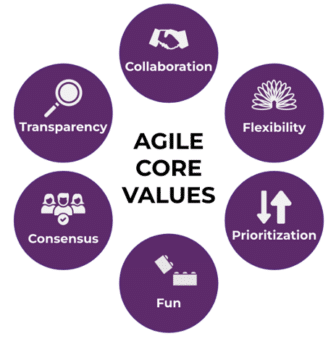
Collaboration
While collaboration in today’s virtual world looks different today than it did a few 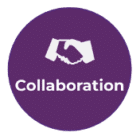 years ago, teams that maintain a strong collaborative environment can promote employee engagement and retention. Numerous studies and experts indicate that engaged employees stay with their organizations longer.
years ago, teams that maintain a strong collaborative environment can promote employee engagement and retention. Numerous studies and experts indicate that engaged employees stay with their organizations longer.
These days, it’s not uncommon for teams to work and interact with groups across the globe. That’s certainly the case at EK. Collaboration at a distance has become critical when working with our clients. On many of our projects, we use approaches like virtual whiteboarding (Miro, Mural), stand-ups, and interactive messaging tools (Slack) to create modern, synergetic work environments. Whiteboarding has been particularly effective when helping our clients in the brainstorming phase of projects. It allows for many individuals to engage with a topic simultaneously, and is often a fun exercise that mimics the sensation of being in the same room together. It’s important to note that with these approaches, skilled facilitators are often needed to ensure adequate participation, and to create a safe space for those involved.
We have found that insights and information that are collaboratively derived are more likely to be understood and retained, and the individuals who contribute are more likely to find their work engaging, and want to stick around.
Consensus
Employees often value workplaces and teams where their opinions are heard and taken seriously.  In fact, one of the leading factors that is driving workers away is the feeling of being disrespected. The idea of reaching consensus on any team can seem difficult on the surface, but Agile teams try to reach it whenever possible. Teams can facilitate collective alignment through activities such as planning poker (used to estimate effort on tasks), dot voting, or other interactive exercises. Consensus can also be sought after on topics like team priorities, meeting cadences, and approaches to take when tackling a difficult problem or task.
In fact, one of the leading factors that is driving workers away is the feeling of being disrespected. The idea of reaching consensus on any team can seem difficult on the surface, but Agile teams try to reach it whenever possible. Teams can facilitate collective alignment through activities such as planning poker (used to estimate effort on tasks), dot voting, or other interactive exercises. Consensus can also be sought after on topics like team priorities, meeting cadences, and approaches to take when tackling a difficult problem or task.
At EK, we often seek to reach consensus on the amount of work we are pulling into a given sprint. We’ve found that even when individuals disagree, the goal of consensus often creates an engaging dialogue that surfaces insights or questions that would have been missed otherwise. These conversations are productive, and the team is almost always better off for it.
While consensus isn’t always possible, making a genuine effort to listen to the voices and opinions of members of a team can go a long way in helping them feel respected and valued. This in turn can reduce the likelihood of a toxic team culture developing, which is a common cause for driving workers away from their jobs.
Transparency
Transparency is crucial to promoting employee retention. 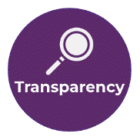 In terms of Agility, we define this as the ability of individuals to quickly and easily discern the intent and progress of a given piece of work. The benefits include fewer status meetings, and more accessible knowledge. Transparency can be supported through Agile tools such as Trello or Slack, which can be used to flatten teams, bring employees closer to leadership, and create a digital “single source of truth.” Collectively, these can replace the need for burdensome micromanagement that often weighs heavily on employees. Furthermore, these tools can help teams manage information overload, and provide them with a hub for storing and recalling key information and knowledge.
In terms of Agility, we define this as the ability of individuals to quickly and easily discern the intent and progress of a given piece of work. The benefits include fewer status meetings, and more accessible knowledge. Transparency can be supported through Agile tools such as Trello or Slack, which can be used to flatten teams, bring employees closer to leadership, and create a digital “single source of truth.” Collectively, these can replace the need for burdensome micromanagement that often weighs heavily on employees. Furthermore, these tools can help teams manage information overload, and provide them with a hub for storing and recalling key information and knowledge.
Transparency also plays a key role in employee retention beyond day-to-day work – particularly during the COVID era. Leaders must be completely transparent as to their planning. At EK, our leadership team has been up front with their thinking throughout the pandemic, and hasn’t been afraid to say they don’t know what the future will precisely look like. That type of thinking may be scary to traditionally need-to-know leadership styles, but leadership’s openness and flexibility in an era of uncertainty has fostered trust and led to improved employee retention.
Flexibility
Few teams and organizations could have predicted or planned for the global events that have unfolded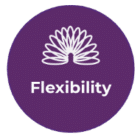 over the last two years, of which the ripple effects have dramatically changed how most people work. As a result, most of the workforce has come to expect flexibility in when and where they perform their jobs. In fact, over 40% of employees would leave their current job for a more flexible work environment.
over the last two years, of which the ripple effects have dramatically changed how most people work. As a result, most of the workforce has come to expect flexibility in when and where they perform their jobs. In fact, over 40% of employees would leave their current job for a more flexible work environment.
While no single team or organization can change the effects of these larger global events, teams can always choose how they respond to these changes. Teams that allow for flexibility in where team members are located, the frequency and duration of meetings or sprint cycles, and even working hours, can lead to much happier, more engaged employees.
At EK, we’ve seen this play out for one of our large federal clients that adopted an agency-wide alternative work schedule policy. The policy allows employees to work varied hours suited to their own needs, and take alternate Fridays off by allocating those hours elsewhere. This flexibility is only possible due to the team’s mutual understanding and support, as well as modern collaboration tools that enable work to continue without disruption. Members of the team have reported that they highly value the program, which has greatly helped with retention.
While the above is just a single example, Agile teams that genuinely embrace flexibility will have a much easier time retaining top talent within their organizations than teams that do not. We often try to coach our clients into embracing change when it presents itself. The idea that change is a good thing and should be welcomed should be reinforced from leadership, as it allows individuals and teams to refocus on things of value. That’s at the heart of Agility.
Prioritization
On any team, it’s important to know what things to focus on, and in what order. Employees may grow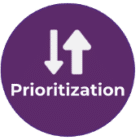 disgruntled if teams are not prioritizing the right things, or direction is unclear. On an Agile team, it’s imperative to not only help individuals prioritize their objectives, but also deprioritize less urgent goals that can become distractions.
disgruntled if teams are not prioritizing the right things, or direction is unclear. On an Agile team, it’s imperative to not only help individuals prioritize their objectives, but also deprioritize less urgent goals that can become distractions.
At EK, we often approach prioritization on our projects by breaking out tasks or features into Must Haves, Should Haves, or Could Haves categorizations. We’ve found that this designation helps manage a team’s workload and morale by creating a clear indicator of what to work on first. With clear and strong prioritization, team members often feel less swamped by everything they need to accomplish, and will be less likely to head for the exits.
Conclusion
The pandemic and the Great Resignation have dramatically changed how people think about work. While people have been leaving their jobs for a myriad of reasons, some of the top causes for leaving are often the result of rigid, inflexible teams. Employee retention can be greatly improved by practicing Agile values. Agile organizations are the foundation of workplaces where individuals feel valued, respected, and more dedicated to their employer and mission. If you’re looking for help on how to customize your team’s Agile transformation and would like to transform your culture in order to retain top talent, our Agile consultants would love to hear from you!
In Part II, we’ll talk about how these same Agile values can be applied to attracting talent.
